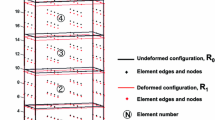Abstract
The stiffness matrix for the Pian–Sumihara element can be obtained in a different way than originally presented in Pian and Sumihara (1984). Instead of getting the element matrix from a hybrid stress formulation with five stress terms one can use a modified Hu–Washizu formulation using nine stress and nine strain terms as well as four enhanced strain terms. Using orthogonal stress and strain functions it becomes possible to obtain the stiffness matrix via sparse B¯-matrices so that numerical matrix inversions can be omitted. The advantage of using the mixed variational formulation with displacements, stresses, strains, and enhanced strains is that the extension to non-linear problems is easily achieved since the final computer implementation is very similar to an implementation of a displacement element.
Similar content being viewed by others
Author information
Authors and Affiliations
Additional information
Received 31 January 2000
Rights and permissions
About this article
Cite this article
Piltner, R. An alternative version of the Pian–Sumihara element with a simple extension to non-linear problems. Computational Mechanics 26, 483–489 (2000). https://doi.org/10.1007/s004660000198
Issue Date:
DOI: https://doi.org/10.1007/s004660000198




